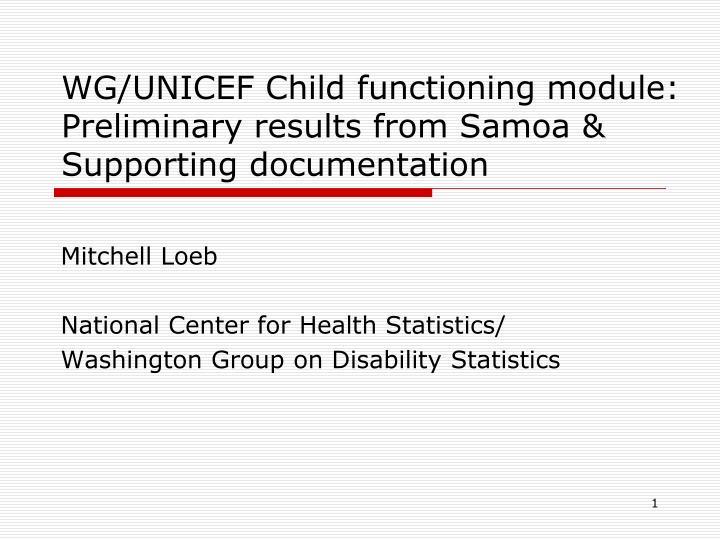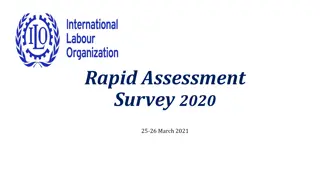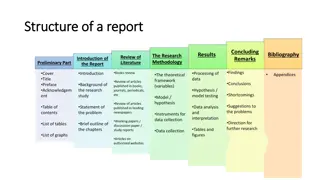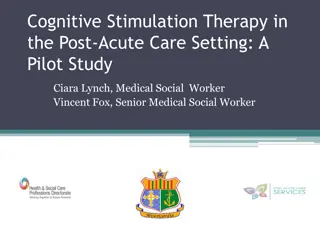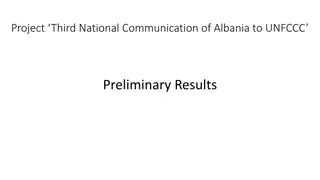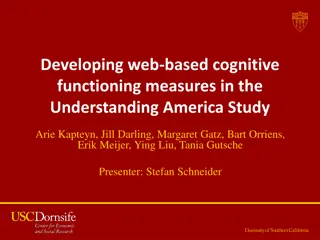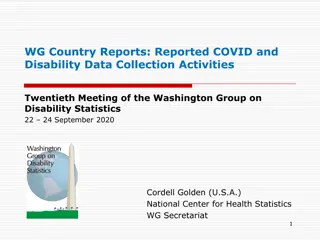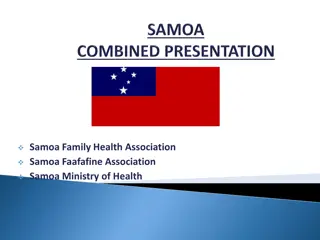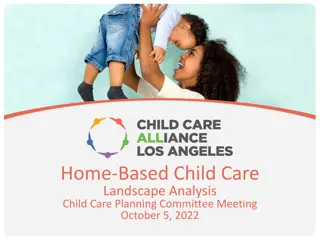Preliminary Results on Child Functioning in Samoa: Insights from Data Collection
In Samoa, the Samoan Bureau of Statistics conducted a Demographic and Health Survey in 2014, which included a study on child functioning and disabilities. The data collected from children aged 2 to 17 years revealed insights into various domains of functioning and difficulties faced, providing a preliminary overview of the situation in the region.
Download Presentation

Please find below an Image/Link to download the presentation.
The content on the website is provided AS IS for your information and personal use only. It may not be sold, licensed, or shared on other websites without obtaining consent from the author.If you encounter any issues during the download, it is possible that the publisher has removed the file from their server.
You are allowed to download the files provided on this website for personal or commercial use, subject to the condition that they are used lawfully. All files are the property of their respective owners.
The content on the website is provided AS IS for your information and personal use only. It may not be sold, licensed, or shared on other websites without obtaining consent from the author.
E N D
Presentation Transcript
WG/UNICEF Child functioning module: Preliminary results from Samoa & Supporting documentation Mitchell Loeb National Center for Health Statistics/ Washington Group on Disability Statistics 1
Samoan data collection: In 2014 the Samoan Bureau of Statistics undertook a Demographic and Health Survey that included a disability component: included the WG short set of questions for those 18 years of age and older included the WG/UNICEF module on child functioning and disability for those 2 through 17 years of age (2 age cohorts: 2-4 years and 5-17 years) 2
Children aged 2-4 years: Total N=2,139 7 domains of functioning: seeing, hearing, walking, communication, learning, behavior, playing Valid data in 4 or more domains of functioning were required for inclusion in analyses. Cases with >3 domains missing = 61 (2.85%): these cases were deleted from analyses Effective N=2,078 (All results are preliminary and unweighted) 3
Difficulty walking (2-4 years): Frequency 2,023 Percent 97.4 Valid Percent No difficulty Some difficulty A lot of difficulty Cannot do at all Sub-total Missing Total 99.1 12 5 2 .6 .2 .1 .6 .2 .1 2,042 98.3 1.7 100.0 100.0 36 2,078 4
Analysis of probe question: A probe was included for those who indicated some or a lot of difficultywalking. 17 responded some (12) or a lot (5) / 15 of these (10 some and 5 a lot) responded to the probe question on concern 0 were of no concern = indicating no false positives All 5 responses of a lot of difficulty were considered a lot of concern 5
Children aged 5-17 years: Total N=7,426 12 domains of functioning: seeing, hearing, walking, self-care, communication, cognition, anxiety, depression, attention, coping with change, behavior, relationships Valid data in 7 or more domains of functioning were required for inclusion in analyses. Cases with > 5 domains missing = 173 (2.32%): these cases were deleted from analyses Effective N=7,253 6
Difficulty with self-care (5-17 years): Frequency Percent Valid Percent No difficulty 7,171 98.9 98.9 Some difficulty 65 .9 .9 A lot of difficulty 12 .2 .2 Cannot do at all 5 .1 .1 Total 7,253 100.0 100.0 7
Analysis of probe question: A probe was included for those who indicated some or a lot of difficulty on the self-care question (feeding/dressing). 77 responded some (65) or a lot (12) / 71 of these (60 some and 11 a lot) responded to the probe question on concern 4 (some difficulty) were of no concern = indicating few false positives All 11 responses of a lot of difficulty were considered a lot of concern 8
Difficulty remembering things (5-17 years): Frequency 7,144 Percent 98.5 Valid Percent No difficulty Some difficulty A lot of difficulty Cannot do at all Sub-total Missing Total 98.6 1.1 78 21 6 1.1 .3 .1 99.9 .3 .1 7,249 100.0 4 .1 7,253 100.0 9
Analysis of probe question: A probe was included for those who indicated some or a lot of difficultyremembering things. 99 responded some (78) or a lot (21) / 97 of these (76 some and 21 a lot) responded to the probe question on concern 1 (some difficulty) were of no concern = indicating few false positives 19 of 21 responses of a lot of difficulty were considered a lot of concern 10
Difficulty with changes in routine (5-17 years): Frequency 7,157 Percent 98.7 Valid Percent No difficulty Some difficulty A lot of difficulty Cannot do at all Sub-total Missing Total 98.8 1.0 69 9 8 1.0 .1 .1 99.9 .1 .1 7,243 100.0 10 .1 7,253 100.0 11
Analysis of probe question: A probe was included for those who indicated some or a lot of difficultyaccepting changes to routine. 78 responded some (69) or a lot (9) / 75 of these (66 some and 9 a lot) responded to the probe question on concern 2 (some difficulty) were of no concern = indicating few false positives All 9 responses of a lot of difficulty were considered a lot of concern 12
Crude Disability Prevalence estimates: Age in years 2 4 5 9 10-17 2 17 Number of domains 7 12 Minimum # of effective domains 4 or more 7 or more Number of cases 2,078 3,021 4,232 9,331 Cut-off is cannot do at all in at least 1 domain 2.1 0.8 2.7 2.3 Cut-off is at least a lot of difficulty in at least 1 domain Cut-off is some difficulty in at least 2 domains Cut-off is some difficulty in at least 1 domain 4.1 3.0 5.3 3.7 6.2 10.3 7.2 3.4 13.6 21.9 15.0 8.5 13
Guidelines for producing statistics on children with disabilities Objective: Provide guidance for those considering collecting data on children with disabilities Discusses conceptual and theoretical issues related to measuring disability Includes considerations for designing, planning, and implementing the collection of data on children with disabilities Expected to be ready in early 2016 14
Table of contents Chapter 1: Overview Chapter 2: The importance of monitoring child development and disability Chapter 3: Concepts and definitions Chapter 4: Assessing environmental factors and participation in child disability Chapter 5: Key domains of child development and disability Chapter 6: Review of methods /tools used to measure disability in children Chapter 7: Key considerations in planning, designing, and implementing the collection of data on disability in children Chapter 8: Data analysis and dissemination Chapter 9: Translating knowledge into action Chapter 10: Conclusions 15
Manual/Users Guide for the UNICEF/WG child functioning and disability module Objective: This manual provides background information on the development of the module, as well as technical information that will be useful for countries intending to implement it. The manual should be used in conjunction with the general Multiple Indicator Cluster Survey (MICS) manual which discusses the overall survey methodology in detail. Expected to be ready in early 2016 16
Table of contents Chapter 1: The Importance of Disability Statistics for Children: discusses the need for reliable data that is comparable across countries; the complexities in collecting such data and findings from previous data collection efforts. Chapter 2: Background: presents the International Classification of Functioning, Disability and Health (ICF) as the conceptual framework for the child functioning and disability module and describes the steps that UNICEF and the WG used to design, test and validate the instrument. Chapter 3: How to Use the Module: presents options for using the questionnaire as a module in an ongoing household survey such as the MICS or the Demographic Health Survey (DHS), as a screening tool for a two-stage data collection process or as a stand- alone module in a health or disability survey. 17
Table of contents Chapter 4: Content of the Module: describes the rationale behind each question and how the module differs from questionnaires designed to measure disability among adults. Chapter 5: Implementing the Module: provides special instructions about translation, pretesting, sample requirements, identification of respondents and eligible children and guidelines for customization Chapter 6 Data processing: provides guidance and for entering the data and syntaxes for data processing. Chapter 7 Data analysis and dissemination: provides guidance for analysing and interpreting the findings, calculating indicators, and tabulating and reporting the data. 18
Workshops on the measurement of child disability Purpose: Tobuild/strengthen local capacity for data collection, interpretation, and use. Content: Concepts, models and measures of disability, survey design, data processing, data analysis, data dissemination and data use. Audience(s): National Statistics Offices, other Government staff, local researchers, DPOs, etc. When: The workshops are expected to take place in 2015/2016. Where: All 7 UNICEF regions (Latin America and the Caribbean, West and Central Africa, East and Southern Africa, Middle East and North Africa, CEE/CIS, East Asia and the Pacific, and South Asia). 19
